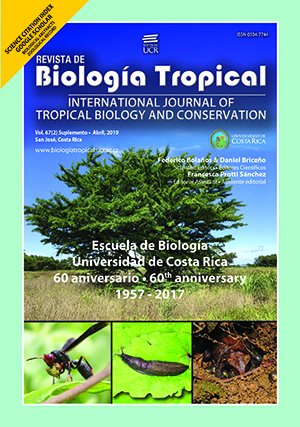Resumen
El estudio de los patrones fenológicos en comunidades de plantas es de importancia vital para entender los ciclos temporales de los ecosistemas, pero hay poca información sobre la diversidad de patrones fenológicos que pueden ocurrir a nivel intraespecífico, así como sobre los factores genéticos o ambientales que explican esta variación. En Handroanthus ochraceus, una especie arbórea de bosques secos, estudios ecofisiológicos han propuesto la reducción del estrés hídrico como el mecanismo que dispara la floración y la brotación de hojas nuevas. Durante cuatro años se observaron los ciclos de caída de hojas, floración, fructificación y producción de hojas nuevas en esta especie en siete sitios en Costa Rica, que diferían en su proximidad a fuentes de agua y por consiguiente en los niveles de humedad del suelo. Dos patrones fenológicos generales fueron observados: el patrón explosivo, en el cual los árboles dependen de las primeras lluvias para desarrollar la antesis floral y la expansión de los meristemos foliares, y el patrón escalonado, en el cual los árboles pueden florecer en una forma modular durante el comienzo y parte media de la estación seca, en forma independiente de las lluvias. Aunque esta variación en patrones fenológicos ha sido previamente reconocida, en este estudio se demuestra por vez primera que esta variación no está necesariamente asociada a diferentes niveles de humedad del suelo, contradiciendo modelos fenológicos propuestos para esta especie de árbol.
Citas
Ashton, P. S., Givnish, T. J., & Appanah, S. (1988). Staggered flowering in the Dipterocarpaceae: new insights into floral induction and the evolution of mast fruiting in the aseasonal tropics. The American Naturalist, 132, 44-66.
Barros, M. G. (2001). Pollination ecology of Tabebuia aurea (Manso) Benth. & Hook. and T. ochracea (Cham.) Standl. (Bignoniaceae) in Central Brazil cerrado vegetation. Brazilian Journal of Botany, 24, 255-261.
Borchert, R. (1994a). Induction of rehydration and bud break by irrigation or rain in decidous trees of a tropical dry forest in Costa Rica. Trees-Structure and Function, 8, 198-204.
Borchert, R. (1994b). Soil and stem water storage determine phenology and distribution of tropical dry forest trees. Ecology, 75, 1437-1449.
Borchert, R., Meyer, S. A., Felger, R. S., & Porter-Bolland, L. (2004). Environmental control of flowering periodicity in Costa Rican and Mexican tropical dry forests. Global Ecology and Biogeography, 13, 409-425.
Dahlgren, J. P., von Zeipel, H., & Ehrlén, J. (2007). Variation in vegetative and flowering phenology in a forest herb caused by environmental heterogeneity. American Journal of Botany, 94, 1570-1576.
Frankie, G. W., Baker, H. G., & Opler, P. A. (1974). Comparative phenological studies of trees in tropical wet and dry forests in the lowlands of Costa Rica. Journal of Ecology, 62, 881-919.
Fournier, L. A. (1974). Método cuantitativo para la medición de características fenológicas en árboles. Turrialba, 24, 422-423.
Fuchs, E. J., Lobo, J. A., & Quesada, M. (2003). Effects of forest fragmentation and flowering phenology on the reproductive success and mating patterns of the tropical dry forest tree Pachira quinata. Conservation Biology, 17, 149-157.
Gentry, A. H. (1970). A revision of Tabebuia (Bignoniaceae) in Central America. Brittonia, 22, 246-264.
Gentry, A. H. (1974). Flowering phenology and diversity in tropical Bignoniaceae. Biotropica, 6, 64-68.
Gentry, A. H. (1992). Bignoniaceae: Part II (Tribe Tecomeae). Flora Neotropica, 25, 1-370.
Grose, S. O., & Olmstead, R. G. (2007). Taxonomic revisions in the polyphyletic genus Tabebuia s.l. (Bignoniaceae). Systematic Botany, 32, 660-670.
Herrerías-Diego, Y., Quesada, M., Stoner, K. E., & Lobo, J. A. (2006). Effects of forest fragmentation on phenological patterns and reproductive success of the tropical dry forest tree Ceiba aesculifolia. Conservation Biology, 20, 1111-1120.
Holdridge, L. R., & Tosi, J. A. (1967). The life zone. Life Zone Ecology. San José, Costa Rica: Tropical Science Center.
Instituto Meterológico Nacional (IMN). (2015). Boletín del ENOS No. 79 (Informe 14). San José, Costa Rica. Recuperado de https://www.imn.ac.cr/documents/10179/28160/%23%2079
Neil, K., & Wu, J. (2006). Effects of urbanization on plant flowering phenology: a review. Urban Ecosystems, 9, 243-257.
Opler, P. A., Frankie, G. W., & Baker, H. G. (1976). Rainfall as a factor in the release, timing, and synchronization of anthesis by tropical trees and shrubs. Journal of Biogeography, 3, 231-236.
Reich, P. B., & Borchert, R. (1982). Phenology and ecophysiology of the tropical tree, Tabebuia neochrysantha (Bignoniaceae). Ecology, 63, 294-299.
Reich, P. B., & Borchert, R. (1984). Water stress and tree phenology in a tropical dry forest in the lowlands of Costa Rica. Journal of Ecology, 72, 61-74.
Rivera, G., Elliott, S., Caldas, L. S., Nicolossi, G., Coradin, V. T., & Borchert, R. (2002). Increasing day-length induces spring flushing of tropical dry forest trees in the absence of rain. Trees-Structure and Function, 16, 445-456.
Sakai, S., Momose, K., Yumoto, T., Nagamitsu, T., Nagamasu, H., Hamid, A. A., & Nakashizuka, T. (1999). Plant reproductive phenology over four years including an episode of general flowering in a lowland dipterocarp forest, Sarawak, Malaysia. American Journal of Botany, 86, 1414-1436.
SanMartin-Gajardo, I., & Morellato, P. C. (2003). Inter and intraspecific variation on reproductive phenology of the Brazilian Atlantic forest Rubiaceae: ecology and phylogenetic constraints. Revista de Biología Tropical, 51, 691-698.
Wright, S. J., & Van Schaik, C. P. (1994). Light and the phenology of tropical trees. The American Naturalist, 143, 192-199.
Wright, S. J., & Calderón, O. (2006). Seasonal, El Nino and longer term changes in flower and seed production in a moist tropical forest. Ecology letters, 9, 35-44.
##plugins.facebook.comentarios##

Esta obra está bajo una licencia internacional Creative Commons Atribución 4.0.
Derechos de autor 2019 Revista de Biología Tropical






